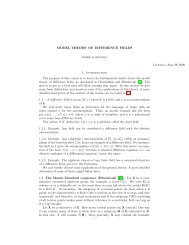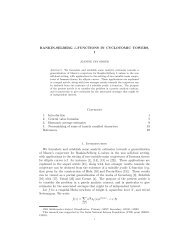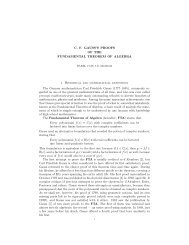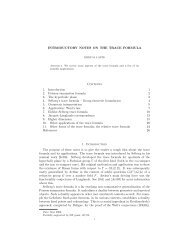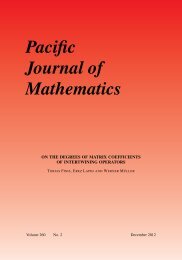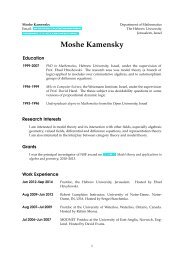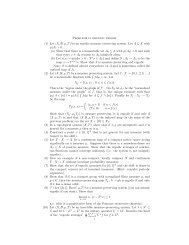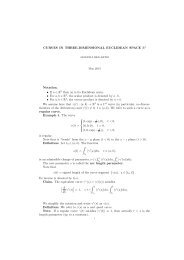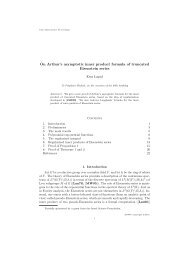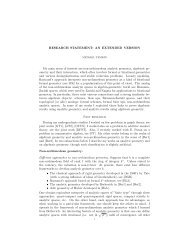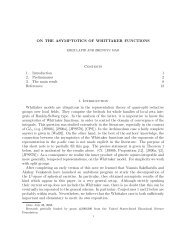H k is a Hilbert space with norm ||f|| Hk = inf{||v|| H1 : Λ v,0 ◦ ψ = f}. <strong>The</strong> subscript kindicates that H k is uniquely determined (as a Hilbert space) given the <strong>kernel</strong> k. With thisinterpretation, program (5) is equivalent to the programmin Err D,l (f + b) s.t. ||f|| Hk ≤ C . (6)f∈H k ,b∈RFor simplicity we focus on l being the hinge-loss (the generalization to other surrogate lossfunctions is rather technical).<strong>The</strong> pro<strong>of</strong> may be split into four steps:(1. Our first step is to show that we can restrict to the case C = poly1γ). We showthat for every subset X <strong>of</strong> a Hilbert space H, if affine functionals on X can be learnt<strong>using</strong> m examples w.r.t. the hinge loss, then there exists an equivalent inner producton H under which X is contained in a unit ball, and the affine functional returned byany <strong>learning</strong> algorithm must have norm ≤ O (m 3 ). Since we consider algorithms with(polynomial sample complexity, this allows us to argue as if C = poly2. We consider the one-dimensional problem <strong>of</strong> improperly <strong>learning</strong> <strong>halfspaces</strong> (i.e.thresholds on the line) by optimizing the hinge loss over the space <strong>of</strong> univariate polynomials<strong>of</strong> degree bounded by log(C). We construct a distribution D over [−1, 1] × {±1}that is a convex combination <strong>of</strong> two distributions. One that is separable by a γ-marginhalfspace and the other representing a tiny amount <strong>of</strong> noise. We show that each solution<strong>of</strong> the problem <strong>of</strong> minimizing the hinge-loss w.r.t. D over the space <strong>of</strong> suchpolynomials has the property that f(γ) ≈ f(−γ).3. We pull back the distribution D w.r.t. a direction e ∈ S d−1 to a distribution overS d−1 × {±1}. Let f be an approximate solution <strong>of</strong> program (6). We show that f takesalmost the same value on instances for which 〈x, e〉 = γ and 〈x, e〉 = −γ. This stepcan be further broken into three substeps –(a) First, we assume that the <strong>kernel</strong> is symmetric and f(x) depends only on 〈x, e〉.This substep uses a characterization <strong>of</strong> Hilbert spaces corresponding to symmetric<strong>kernel</strong>s, from which it follows that f has the form∞∑f(x) = α n P d,n (〈x, e〉) .n=1Here P d,n are the d-dimensional Legendre polynomials and ∑ ∞n=0 α2 n < C 2 . Thisallows us to rely on the results for the one-dimensional case from step (1).(b) By symmetrizing f, we relax the assumption that f depends only on 〈x, e〉.(c) By averaging the <strong>kernel</strong> over the group <strong>of</strong> linear isometries on R d , we relax theassumption that the <strong>kernel</strong> is symmetric.4. Finally, we show that for the distribution from the previous step, if f is an approximatesolution to program (6) then f predicts the same value, 1, on instances for which〈x, e〉 = γ and 〈x, e〉 = −γ. This establishes our claim, as the constructed distributionassigns the value −1 to instances for which 〈x, e〉 = −γ.91γ).
We now expand on this brief description <strong>of</strong> the main steps.Polynomial sample implies small CLet X be a subset <strong>of</strong> the unit ball <strong>of</strong> some Hilbert space H and let C > 0. Assume thataffine functionals over X with norm ≤ C can be learnt <strong>using</strong> m examples with <strong>error</strong> ɛ andconfidence δ. That is, assume that there is an algorithm such that• Its input is a sample <strong>of</strong> m points in X × {±1} and its output is an affine functionalΛ w,b with ‖w‖ ≤ C.• For every distribution D on X × {±1}, it returns, with probability 1 − δ, w, b withErr D,hinge (Λ w,b ) ≤ inf ‖w ′ ‖≤C,b ′ ∈R Err D,hinge (Λ w ′ ,b′) + ɛ.We will show that there is an equivalent inner product 〈·, ·〉 ′ on H under which X is containedin a unit ball (not necessarily around 0) and the affine functional returned by any <strong>learning</strong>algorithm as above, must have norm ≤ O (m 3 ) w.r.t. the new norm.<strong>The</strong> construction <strong>of</strong> the norm is done as follows. We first find an affine subspace M ⊂ H<strong>of</strong> dimension d ≤ m that is very close to X in the sense that the distance <strong>of</strong> every pointin X from M is ≤ m . To find such an M, we assume toward a contradiction that there isCno such M, and use this to show that there is a subset A ⊂ X such that every functionf : A → [−1, 1] can be realized by some affine functional with norm ≤ C. This contradictsthe assumption that affine functionals with norm ≤ C can be learnt <strong>using</strong> m examples.Having the subspace M at hand, we construct, <strong>using</strong> John’s lemma (e.g. Matousek(2002)), an inner product 〈·, ·〉 ′′ on M and a distribution µ N on X with the property thatthe projection <strong>of</strong> X on M is contained in a ball <strong>of</strong> radius 1 w.r.t. 〈·, 2 ·〉′′ , and the hinge <strong>error</strong><strong>of</strong> every affine functional w.r.t. µ N is lower bounded by the norm <strong>of</strong> the affine functional,divided by m 2 . We show that that this entails that any affine functional returned by thealgorithm must have a norm ≤ O (m 3 ) w.r.t. the inner product 〈·, ·〉 ′′ .Finally, we construct an inner product 〈·, ·〉 ′ on H by putting the norm 〈·, ·〉 ′′ on M andmultiplying the original inner product by C2 on M ⊥ .2m 2<strong>The</strong> one dimensional distributionWe define a distribution D on [−1, 1] as follows. Start with the distribution D 1 that takes thevalues ±(γ, 1), where D 1 (γ, 1) = 0.7 and D 1 (−γ, −1) = 0.3. Clearly, for this distribution,the threshold 0 has zero <strong>error</strong> <strong>rate</strong>. To construct D, we perturb D 1 with “noise” as follows.Let D = (1 − λ)D 1 + λD 2 , where D 2 is defined as follows. <strong>The</strong> probability <strong>of</strong> the labels isuniform and independent <strong>of</strong> the instance and the marginal probability over the instances isdefined by the density function{0 if |x| > 1/8ρ(x) =√8if |x| ≤ 1/8 .π 1−(8x) 2This choice <strong>of</strong> ρ simplifies our calculations due to its relation to Chebyshev polynomials.However, other choices <strong>of</strong> ρ which are supported on a small interval around zero can alsowork.10
- Page 1 and 2: The complexity of learning halfspac
- Page 3 and 4: exists an equivalent inner product
- Page 5 and 6: is enough that we can efficiently c
- Page 7 and 8: our terminology, they considered th
- Page 9: It is shown in (Birnbaum and Shalev
- Page 13 and 14: and (uniformly and independently) a
- Page 15 and 16: The proof of Theorem 2.7To prove Th
- Page 17 and 18: attempts to prove a quantitative op
- Page 19 and 20: 5.1.3 Harmonic Analysis on the Sphe
- Page 21 and 22: Lemma 5.11 (John’s Lemma) (Matous
- Page 23 and 24: For 1 ≤ i ≤ t Let v i = x i −
- Page 25 and 26: ( )that in this case Err µN ,hinge
- Page 27 and 28: Thus, it is enough to find a neighb
- Page 29 and 30: Legendre polynomials we have|P d,n
- Page 31 and 32: Then, for every K ∈ N, 1 8 > γ >
- Page 33 and 34: Now, it holds that∫∫∫ ∫∫
- Page 35 and 36: We note that ω f◦g ≤ ω f ·
- Page 37 and 38: Now, denote δ = ∫ g. It holds th
- Page 39 and 40: equivalent formulationminErr D,l (f
- Page 41 and 42: Denote ||g|| Hk = C. By Lemma 5.25,
- Page 43 and 44: Consequently, every approximated so
- Page 45: Kosaku Yosida. Functional Analysis.




